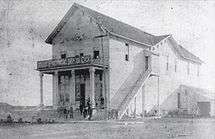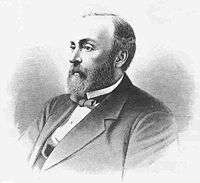Pere Marquette Lumber Company
The Pere Marquette Lumber Company was a lumber, salt, sawyering and merchandising company of the nineteenth century. Its initial purpose was as an asset management company. The holdings were that of James Ludington, a lumber baron. The business firm was the cradle for the development of the city of Ludington, Michigan. The company was an important component of the lumber boom and bust in the area, supplying lumber for hundreds of thousands of homes and other structures in the Midwest. It was one of the largest producers of salt in the state of Michigan. The company was active from 1869 to 1897 and later sold.
 | |
| Fate | sold |
|---|---|
| Founded | 1869 |
| Defunct | 1900 |
| Headquarters | Ludington, Michigan |
| Products | merchandise, lumber, salt |
Background

Ludington's holdings contained in part 360 acres that included the lots of the village of Pere Marquette in Mason County in the northwestern part of Michigan in its lower peninsula.[1] The village lots were sold out to individuals and became the core of a town that in 1873 would become the city of Ludington.[2] The city became the terminus of the Flint and Pere Marquette Railroad that ultimately became a railway line to Wisconsin via carferries across Lake Michigan.[3] This became the home port of the largest carferry fleet in the world.[4]
The village's sawmill was also owned by Ludington.[1] It was the oldest sawmill in northwestern Michigan and had been operating since 1848.[5] The sawmill had been owned by different men until 1859 when it became the property of Ludington through a foreclosure.[6] In addition, he owned a parcel of land of 25,000 acres that contained white pine timber that could be turned into lumber for construction. The parcel was situated on the Pere Marquette River in Mason County, Lake County, Newaygo County, and Oceana County in northwestern Michigan near the village of Pere Marquette.[2]
History
.jpg)
Ludington had failing health in the late 1860s and felt he could no longer manage his vast holdings in Michigan. The Pere Marquette Lumber Company was then formed to buy his holdings to take over the management. The new lumber company arrangement came under the guidance of Delos L. Filer.[7] Ludington's holdings were bought out by the new lumber company with $500,000 cash. It was officially organized on July 24, 1869.[6] The members of the new company were Ludington, Filer, John Mason Loomis, Edward A. Foster and Luther H. Foster. The officers of the new company were Filer as president, Loomis as treasurer, with L. H. Foster and James Ludington as secretaries. The stock of the new lumber company was divided up proportionally when they pooled together the money to buy out Ludington's holdings.[8][9]
Ludington had built a large commercial store in the village of Pere Marquette built in 1867 called The Big Store. The store sold all kinds of general merchandise to the public. For years it was the largest retailer for Mason County. It advertised with the slogan "Large sales and small profits." The second story of the building was used for the offices of the lumber company and from time to time as a church and public library.[10]
The sawmills of the Pere Marquette Lumber Company consisted originally of the basic saws of the time when first operated in the 1870s. The mills manufactured about three to four million board feet (FBM) of lumber yearly. The company gradually improved and updated the machinery of their sawmills as time went on to the latest equipment. The sawmills were capable of producing 10,000,000 board feet per year by 1880. Later more improvements were added to their sawmills so that 12 to 15 million FBM per year could be produced.[11]
The company branched out into the salt business in 1883. At that time the new salt business division started boring a well for a salt bed. The salt enterprise was successful in 1885 when it had drilled a well 2,220 feet deep.[12] The lumber company used leftover timber from their sawmills in its production for burning to distill salt from the brine brought up from the drilled well. The salt enterprise had the capability to produce about four hundred barrels of salt per day when first started producing salt in 1885.[13] The salt division produced about 90,000 barrels of salt annually by 1898.[8] The grades of salt produced were No. 1 fine grade, and packers' salt.
The company ranked among the largest salt and lumber producers in the state of Michigan by 1890. These were important industries to develop out the city of Ludington.[8] The Pere Marquette Lumber Company ceased operating in 1897 when its timber supply was used up.[14] The company was sold to the Michigan Salt Association in 1900.[15] This company should not be confused with the Pere Marquette Lumber and Boom Company.[16]
Legacy
The Michigan State University Archives and Historical Collections holds three cubic feet in 17 binders of the company's records.[17] The Ludington Public Library started with the Ludington Library Association from a meeting held at Ludington Hall on the second story of the Pere Marquette Lumber Company store on April 9, 1872.[18]
References
Citations
- Peterson 2011, p. 26.
- Bersey 1890, p. 103.
- Ivey 1919, pp. 215–236
- "Today Marks 60th Anniversary of Sailing Pere Marquette 15". Daily News. Ludington, Michigan. February 19, 1957 – via Newspapers.com

Feb. 19, 1957 marks the 60th anniversary of the first sailing of the steel carferry Pere Marquette, the beginning of the transportation business which revolutionized shipping on the Great Lakes and made Ludington the home port of the largest carferry fleet in the world.
- Peterson 2011, p. 25.
- Page 1882, p. 45.
- Record 1895, p. 117.
- Hotchkiss 1898, p. 249.
- Hanna 1955, p. 20.
- Cabot 2005, p. 103.
- Hotchkiss 1898, p. 250.
- "75 Years Ago / Ludington Appeal". Daily News. Ludington, Michigan. July 7, 1972 – via Newspapers.com

- Bersey 1890, p. 104.
- Nagle 2015, pp. 41–42.
- Nagle 2015, p. 215.
- Forest Service 2013, p. 62.
- "Pere Marquette Lumber Company Records 00031". Michigan State University Archives and Historical Collections. Retrieved September 29, 2019.
- Cabot, 1991
Bibliography
- Bersey, John (1890). Cyclopedia of Michigan. New York City: Western Publishing & Engraving Company.
The Pere Marquette Lumber Company ranks among the largest salt and lumber producers of the State.
CS1 maint: ref=harv (link)
- Cabot, James L. (1991), 3 part series on the Ludington Public Library / Ludington Daily News, November 9, 1991, Public library, one of earliest institutions
- Cabot, James L. (2005). Ludington 1830-1930. Images of America. San Francisco, California: Arcadia Publishing. ISBN 0-7385-3951-1.CS1 maint: ref=harv (link)
- Forest Service, United States (2013). Manistee National Forest (N.F.), Pere Marquette Wild and Scenic River. Washington, D. C.: United States Department of Agriculture.CS1 maint: ref=harv (link)
- Hanna, Frances C. (1955). Sand, Sawdust and Saw Logs; Lumber Days in Ludington. Ann Arbor, Michigan: Edwards Brothers, Inc.CS1 maint: ref=harv (link)
- Hotchkiss, George Woodward (1898). History of the Forest Industry of Northwest. Chicago, Illinois: G.W. Hotchkiss & Company.
In 1883 this company engaged in the manufacture of salt and now make about 90,000 barrels a year.
CS1 maint: ref=harv (link)
- Ivey, Paul (1919). The Pere Marquette Railroad Company. Lansing, MI: Michigan Historical Commission. OCLC 66109442.CS1 maint: ref=harv (link)
- Nagle, Michael W. (2015). Justus S. Stearns: Michigan Pine King and Kentucky Coal Baron, 1845-1933. Detroit, Michigan: Wayne State University Press. ISBN 0814341276.CS1 maint: ref=harv (link)
- Page, H.R. (1882). History of Mason County, MI. Chicago, Illinois: H.R. Page.CS1 maint: ref=harv (link)
- Peterson, Paul S. (2011). The story of Ludington: Born of Logs, Nurtured by Car Ferries. Forged by Resilience. Phoenix, Arizona: Heritage Publishing. ISBN 978-1-935438-08-3.CS1 maint: ref=harv (link)
- Record (1895). Record of Northern Michigan. Chicago, Illinois: Record Publishing Company. p. 3.
1895 Portrait and biographical record of northern Michigan Chicago, Illinois: Record Publishing Company.
CS1 maint: ref=harv (link)